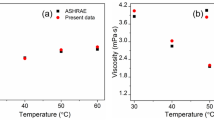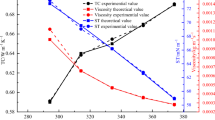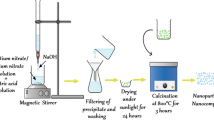Abstract
Nanofluids are suspensions of solid nanoparticles in conventional heat transfer fluids, and they often exhibit improved heat transfer characteristics. Different nanoparticles (metals, oxides, nitrides, etc.) have been used for the synthesis of nanofluids. The nanosized hexagonal form of boron nitride (BN) has versatile properties, such as chemical inertness, electrically insulating and high in-plane thermal conductivity (~ 600 W m−1 K−1) making it a prospective dispersoid in nanofluids for heat transfer applications. The present study reports the synthesis of pure ethylene glycol (EG)- and ethylene glycol–water mixture (EG/W, 40/60 vol. ratio)-based nanofluids containing a dispersion of BN nanoparticles. Form the study, it emerged that with the increase in particle concentration, the BN nanofluids showed an increment in the thermal conductivity manifesting a maximum of 15.5% and 12.5% for 3 vol.% of BN dispersion in EG- and EG/W-based nanofluids, respectively. Also, the thermal conductivity enhancement of BN nanofluids was found to be nearly independent of temperature in the temperature range of 30–60 °C. The viscosity of BN nanofluids increased with the increase in particle concentration showing a maximum of 41 and 33% for 2 vol.% of BN in EG-based and EG/W-based nanofluids, respectively. Further, BN nanofluids exhibited shear-thinning behaviour at lower shear rates and a Newtonian nature at higher shear rates. A new correlation has been developed to estimate the thermal conductivity and viscosity of BN nanofluids on the basis of experimental data.















Similar content being viewed by others
References
Choi SUS, Eastman J. Enhancing thermal conductivty of fluids with nanoparticles. ASME FED, 231. 1995
Lee S, Choi SU-S, Li S, Eastman JA. Measuring thermal conductivity of fluids containing oxide nanoparticles. J Heat Transfer. 1999;121:280.
Das SK, Putra N, Thiesen P, Roetzel W. Temperature dependence of thermal conductivity enhancement for nanofluids. J Heat Transfer. 2003;125:567.
Zhu H, Zhang C, Liu S, Tang Y, Yin Y. Effects of nanoparticle clustering and alignment on thermal conductivities of Fe3O4 aqueous nanofluids. Appl Phys Lett. 2006;89:023123.
Namburu PK, Kulkarni DP, Misra D, Das DK. Viscosity of copper oxide nanoparticles dispersed in ethylene glycol and water mixture. Exp Therm Fluid Sci. 2007;32:397–402.
Yu W, Xie H, Chen L, Li Y. Investigation of thermal conductivity and viscosity of ethylene glycol based ZnO nanofluid. Thermochim Acta. 2009;491:92–6.
Hojjat M, Etemad SG, Bagheri R, Thibault J. Rheological characteristics of non-Newtonian nanofluids: experimental investigation. Int Commun Heat Mass Transf. 2011;38:144–8.
Pastoriza-Gallego M, Lugo L, Legido J, Piñeiro MM. Thermal conductivity and viscosity measurements of ethylene glycol-based Al2O3 nanofluids. Nanoscale Res Lett. 2011;6:221.
Kole M, Dey TK. Thermophysical and pool boiling characteristics of ZnO-ethylene glycol nanofluids. Int J Therm Sci. 2012;62:61–70.
Suganthi KS, Rajan KS. Temperature induced changes in ZnO–water nanofluid: zeta potential, size distribution and viscosity profiles. Int J Heat Mass Transf. 2012;55:7969–80.
Ghosh MM, Ghosh S, Pabi SK. On synthesis of a highly effective and stable silver nanofluid inspired by its multiscale modeling. Nanosci Nanotechnol Lett. 2012;4:843–8.
Karthik V, Sahoo S, Pabi SK, Ghosh S. On the phononic and electronic contribution to the enhanced thermal conductivity of water-based silver nanofluids. Int J Therm Sci. 2013;64:53–61.
Syam Sundar L, Venkata Ramana E, Singh MK, Sousa ACM. Thermal conductivity and viscosity of stabilized ethylene glycol and water mixture Al2O3 nanofluids for heat transfer applications: an experimental study. Int Commun Heat Mass Transf. 2014;56:86–95.
Li H, He Y, Hu Y, Jiang B, Huang Y. Thermophysical and natural convection characteristics of ethylene glycol and water mixture based ZnO nanofluids. Int J Heat Mass Transf. 2015;91:385–9.
Chen M, He Y, Zhu J, Wen D. Investigating the collector efficiency of silver nanofluids based direct absorption solar collectors. Appl Energy. 2016;181:65–74.
Aparna Z, Ghosh S, Pabi SK. The difference in the thermal conductivity of nanofluids measured by different methods and its rationalization. Beilstein J Nanotechnol. 2016;7:2037–44.
Aparna Z, Michael MM, Pabi SK, Ghosh S. Diversity in thermal conductivity of aqueous Al2O3- and Ag-nanofluids measured by transient hot-wire and laser flash methods. Exp Therm Fluid Sci. 2018;94:231–45.
Guo Y, Zhang T, Zhang D, Wang Q. Experimental investigation of thermal and electrical conductivity of silicon oxide nanofluids in ethylene glycol/water mixture. Int J Heat Mass Transf. 2018;117:280–6.
Moghaddari M, Yousefi F. Syntheses, characterization, measurement and modeling viscosity of nanofluids containing OH-functionalized MWCNTs and their composites with soft metal (Ag, Au and Pd) in water, ethylene glycol and water/ethylene glycol mixture. J Therm Anal Calorim. 2018. https://doi.org/10.1007/s10973-018-7150-x.
Kulkarni DP, Namburu PK, Bargar HE, Das DK. Convective heat transfer and fluid dynamic characteristics of SiO2-ethylene glycol/water nanofluid. Heat Transf Eng. 2008;29:1027–35.
Sahooli M, Sabbaghi S. Investigation of thermal properties of CuO nanoparticles on the ethylene glycol–water mixture. Mater Lett North-Holland. 2013;93:254–7.
Chandra Sekhara Reddy M, Vasudeva Rao V. Experimental investigation of heat transfer coefficient and friction factor of ethylene glycol water based TiO2 nanofluid in double pipe heat exchanger with and without helical coil inserts. Int Commun Heat Mass Transf. 2014;50:68–76.
Azmi WH, Abdul Hamid K, Usri NA, Mamat R, Mohamad MS. Heat transfer and friction factor of water and ethylene glycol mixture based TiO2 and Al2O3 nanofluids under turbulent flow. Int Commun Heat Mass Transf. 2016;76:24–32.
Zareie A, Akbari M. Hybrid nanoparticles effects on rheological behavior of water-EG coolant under different temperatures: an experimental study. J Mol Liq. 2017;230:408–14.
Yousefi F, Sedaghat F. Synthesis, characterization, measurement and modeling thermal conductivity and viscosity of nanofluids containing S, N-GQDs in water, ethylene glycol and their mixtures. Heat Mass Transf. 2018;1:13.
Vajjha RS, Das DK. Experimental determination of thermal conductivity of three nanofluids and development of new correlations. Int J Heat Mass Transf. 2009;52:4675–82. https://doi.org/10.1016/j.ijheatmasstransfer.2009.06.027.
Kumaresan V, Velraj R. Experimental investigation of the thermo-physical properties of water–ethylene glycol mixture based CNT nanofluids. Thermochim Acta. 2012;545:180–6.
Suganthi KS, Leela Vinodhan V, Rajan KS. Heat transfer performance and transport properties of ZnO-ethylene glycol and ZnO-ethylene glycol-water nanofluid coolants. Appl Energy. 2014;135:548–59.
Selvam C, Mohan Lal D, Harish S. Thermophysical properties of ethylene glycol-water mixture containing silver nanoparticles. J Mech Sci Technol. 2016;30:1271–9. https://doi.org/10.1007/s12206-016-0231-5.
Li X, Zou C. Thermo-physical properties of water and ethylene glycol mixture based SiC nanofluids: an experimental investigation. Int J Heat Mass Transf. 2016;101:412–7.
Li Y, Zhou J, Luo Z, Tung S, Schneider E, Wu J, et al. Investigation on two abnormal phenomena about thermal conductivity enhancement of BN/EG nanofluids. Nanoscale Res Lett. 2011;6:443. https://doi.org/10.1186/1556-276X-6-443.
Zhi C, Xu Y, Bando Y, Golberg D. Highly thermo-conductive fluid with boron nitride nanofillers. ACS Nano. 2011;5:6571–7.
Taha-Tijerina J, Narayanan TN, Gao G, Rohde M, Tsentalovich DA, Pasquali M, et al. Electrically insulating thermal nano-oils using 2D fillers. ACS Nano. 2012;6:1214–20. https://doi.org/10.1021/nn203862p.
Aparna Z, Ghosh S, Pabi SK. Influence of container material on the heat transfer characteristics of nanofluids. Exp Heat Transf. 2017;30:302–15. https://doi.org/10.1080/08916152.2016.1247122.
Ungár T, Borbély A. The effect of dislocation contrast on x-ray line broadening: a new approach to line profile analysis. Appl Phys Lett. 1998;69:3173. https://doi.org/10.1063/1.117951.
Garg P, Alvarado JL, Marsh C, Carlson TA, Kessler DA, Annamalai K. An experimental study on the effect of ultrasonication on viscosity and heat transfer performance of multi-wall carbon nanotube-based aqueous nanofluids. Int J Heat Mass Transf. 2009;52:5090–10138.
ASHRAE. 2009 ASHRAE Handbook Fundamentals. Design. 2011.
Beck MP, Yuan Y, Warrier P, Teja AS. The thermal conductivity of alumina nanofluids in water, ethylene glycol, and ethylene glycol + water mixtures. J Nanoparticle Res. 2010;12:1469–77.
Said Z, Sajid MH, Alim MA, Saidur R, Rahim NA. Experimental investigation of the thermophysical properties of AL2O3-nanofluid and its effect on a flat plate solar collector. Int Commun Heat Mass Transf. 2013;48:99–107.
Zyła G, Fal J, Traciak J, Gizowska M, Perkowski K. Huge thermal conductivity enhancement in boron nitride–ethylene glycol nanofluids. Mater Chem Phys. 2016;180:250–5.
Soltanimehr M, Afrand M. Thermal conductivity enhancement of COOH-functionalized MWCNTs/ethylene glycol–water nanofluid for application in heating and cooling systems. Appl Therm Eng. 2016;105:716–23.
Azmi WH, Abdul Hamid K, Mamat R, Sharma KV, Mohamad MS. Effects of working temperature on thermo-physical properties and forced convection heat transfer of TiO2 nanofluids in water–Ethylene glycol mixture. Appl Therm Eng. 2016;106:1190–9.
Yu W, Xie H, Li Y, Chen L, Wang Q. Experimental investigation on the heat transfer properties of Al2O3 nanofluids using the mixture of ethylene glycol and water as base fluid. Powder Technol. 2012;230:14–9.
Timofeeva EV, Gavrilov AN, McCloskey JM, Tolmachev YV, Sprunt S, Lopatina LM, et al. Thermal conductivity and particle agglomeration in alumina nanofluids: experiment and theory. Phys Rev E Stat Nonlinear Soft Matter Phys. 2007;76:061203.
Chiam HW, Azmi WH, Usri NA, Mamat R, Adam NM. Thermal conductivity and viscosity of Al2O3 nanofluids for different based ratio of water and ethylene glycol mixture. Exp Therm Fluid Sci. 2017;81:420–9.
Sandhu H, Gangacharyulu D. An experimental study on stability and some thermophysical properties of multiwalled carbon nanotubes with water–ethylene glycol mixtures. Part Sci Technol. 2017;35:547–54.
Ijam A, Saidur R, Ganesan P, Moradi Golsheikh A. Stability, thermo-physical properties, and electrical conductivity of graphene oxide-deionized water/ethylene glycol based nanofluid. Int J Heat Mass Transf. 2015;87:92–103.
Hamid KA, Azmi WH, Mamat R, Sharma KV. Experimental investigation on heat transfer performance of TiO2 nanofluids in water–ethylene glycol mixture. Int Commun Heat Mass Transf. 2016;73:16–24.
Einstein A. A new determination of molecular dimensions. Ann der Phys. 1906;19:289–306.
Batchelor GK. The effect of Brownian motion on the bulk stress in a suspension of spherical particles. J Fluid Mech. 1977;83:97.
Roscoe R. The viscosity of suspensions of rigid spheres. Br J Appl Phys. 1952;3:267–9.
Brinkman HC. The viscosity of concentrated suspensions and solutions. J Chem Phys. 1952;20:571.
Wang X, Xu XS, Choi SU. Thermal Conductivity of Nanoparticle—Fluid Mixture. J Thermophys Heat Transf. 1999;13:474–80. https://doi.org/10.2514/2.6486.
Acknowledgements
This work has been sponsored by the Grant no. DNRD/05/4003/NRB/248 of the Naval Research Board of DRDO, Government of India. Authors greatly acknowledge Prof. T.K Nandi and Prof. A. Chandra from IIT Kharagpur for providing the experimental facilities to measure viscosity and particle size, respectively.
Author information
Authors and Affiliations
Corresponding author
Electronic supplementary material
Below is the link to the electronic supplementary material.
Rights and permissions
About this article
Cite this article
Michael, M., Zagabathuni, A., Ghosh, S. et al. Thermo-physical properties of pure ethylene glycol and water–ethylene glycol mixture-based boron nitride nanofluids. J Therm Anal Calorim 137, 369–380 (2019). https://doi.org/10.1007/s10973-018-7965-5
Received:
Accepted:
Published:
Issue Date:
DOI: https://doi.org/10.1007/s10973-018-7965-5




